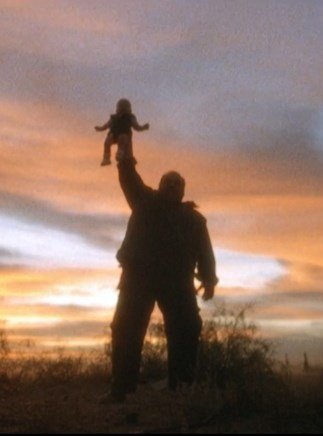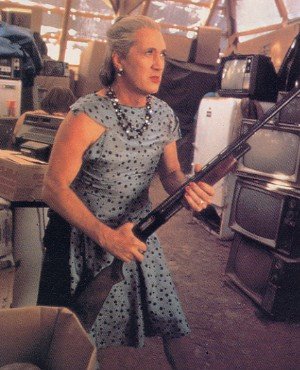SONNY BOY: A Coming-Of-Age Tale For Celluloid Misfits
A film can become a "cult movie" for a variety of reasons: sometimes it remains popular well after its sell-by date, sometimes it's a few years ahead of the curve and other times it earns admiration from a select few because there is nothing else quite like it. The latter category is perhaps the truest, most clearly defined category of cult movie and Sonny Boy fits it perfectly. It's a singular combination of family-themed horror elements, Frankenstein allegory and oddly heartfelt coming-of-age elements that will only speak to a select group... but that group is likely to adore it for its unusual vision. The titular character of Sonny Boy is orphaned as an infant when his parents are killed by car thief Weasel (Brad Dourif), who doesn't know a baby is in the back seat. He gives the baby to his boss Slue (Paul L. Smith), who reluctantly takes the child in when his transvestite lover Pearl (David Carradine!) wants to keep it. The child has his tongue cut out and is raised like a killer animal, used as a weapon by Slue. However, as adulthood approaches, Sonny Boy becomes aware that his life could be different... and when the world takes notice of him, trouble comes calling.The synopsis sound like it could be a gross-out "family horror" film in the vein of The Hills Have Eyes or The Texas Chainsaw Massacre but Sonny Boy has its own unique path to follow. Graeme Whifler's script plays the plot out as a twisted coming-of-age story, with the Candide-like travails of the title character acting as a commentary on how negative parental influences and societal indifference can adversely affect the innocent and the different in our world. The result often has a fairytale quality that dovetails with the horror and dark comedy elements surprisingly well.That's a lot of tones to juggle but director Robert Martin Carroll pulls it off by merging them all into one offbeat style. He uses the film's New Mexico desert settings to haunting, otherworldly effect, with skillful photography by Italian vet Roberto D'Ettore Piazzoli creating a look that combines the epic widescreen vistas of a John Ford movie with with the kind of grungy, white-trash grandeur that would later be seen in Gummo
The titular character of Sonny Boy is orphaned as an infant when his parents are killed by car thief Weasel (Brad Dourif), who doesn't know a baby is in the back seat. He gives the baby to his boss Slue (Paul L. Smith), who reluctantly takes the child in when his transvestite lover Pearl (David Carradine!) wants to keep it. The child has his tongue cut out and is raised like a killer animal, used as a weapon by Slue. However, as adulthood approaches, Sonny Boy becomes aware that his life could be different... and when the world takes notice of him, trouble comes calling.The synopsis sound like it could be a gross-out "family horror" film in the vein of The Hills Have Eyes or The Texas Chainsaw Massacre but Sonny Boy has its own unique path to follow. Graeme Whifler's script plays the plot out as a twisted coming-of-age story, with the Candide-like travails of the title character acting as a commentary on how negative parental influences and societal indifference can adversely affect the innocent and the different in our world. The result often has a fairytale quality that dovetails with the horror and dark comedy elements surprisingly well.That's a lot of tones to juggle but director Robert Martin Carroll pulls it off by merging them all into one offbeat style. He uses the film's New Mexico desert settings to haunting, otherworldly effect, with skillful photography by Italian vet Roberto D'Ettore Piazzoli creating a look that combines the epic widescreen vistas of a John Ford movie with with the kind of grungy, white-trash grandeur that would later be seen in Gummo . The Western element is enhanced by a lovely score from Carlo Maria Cordio that cuts against the grain of the film's grim elements with a lovely use of harmonica and banjo: it's inspired "counter-scoring" in the vein of Riz Ortolani's work with the Jacopetti/Prosperi team.Carroll also shows a sure hand with his interesting and eclectic cast, avoiding any potential campiness or self-conscious weirdness by getting them to deliver performances as naturalistic as their offbeat roles will allow. Smith actually gets dialogue for once and he does well with it, bringing a manipulative intelligence to his imposing physicality. Carradine's role had the biggest potential to be overdone but he overplays it in an inspired, unexpectedly naturalistic way: he's clearly having fun but he gives the character dignity instead of reducing the role to a joke (he also wrote and sung the film's amazing country ballad theme song).
. The Western element is enhanced by a lovely score from Carlo Maria Cordio that cuts against the grain of the film's grim elements with a lovely use of harmonica and banjo: it's inspired "counter-scoring" in the vein of Riz Ortolani's work with the Jacopetti/Prosperi team.Carroll also shows a sure hand with his interesting and eclectic cast, avoiding any potential campiness or self-conscious weirdness by getting them to deliver performances as naturalistic as their offbeat roles will allow. Smith actually gets dialogue for once and he does well with it, bringing a manipulative intelligence to his imposing physicality. Carradine's role had the biggest potential to be overdone but he overplays it in an inspired, unexpectedly naturalistic way: he's clearly having fun but he gives the character dignity instead of reducing the role to a joke (he also wrote and sung the film's amazing country ballad theme song). Elsewhere, Dourif and Sydney Lassick as another criminal cohort have showier roles but avoid going over the top and Conrad Janis does nice work as the film's conscience, an alcoholic but still noble doctor. Finally, little-known actor Michael Griffin gives an amazing physical performance as Sonny Boy, communicating the entire character through a wounded expressiveness in his face and body language.In short, Sonny Boy is worth the investment for ambitious cult movie fans because it is the genuine article: hypnotically bizarre in an unforced way, full of surprises and unexpectedly heartfelt in it how it conveys its unorthodox vision. A film that fits such a description should be treasured - and Sonny Boy deserves to be rediscovered by those who can appreciate celluloid misfits.Blu-Ray Notes: Scream Factory just released this title on blu-ray, marking the first time it has been on video in the U.S. since the days of VHS. It's presented in its original Cinemascope format (another first for this title) and the results look pretty good: there is some age-related speckling but the earthy color scheme comes across nicely and the filter-heavy imagery benefits from the hi-def bump in clarity it gets here. The DTS 2.0 soundtrack offers a solid blend of sonic elements that sounds true to the film's vintage.
Elsewhere, Dourif and Sydney Lassick as another criminal cohort have showier roles but avoid going over the top and Conrad Janis does nice work as the film's conscience, an alcoholic but still noble doctor. Finally, little-known actor Michael Griffin gives an amazing physical performance as Sonny Boy, communicating the entire character through a wounded expressiveness in his face and body language.In short, Sonny Boy is worth the investment for ambitious cult movie fans because it is the genuine article: hypnotically bizarre in an unforced way, full of surprises and unexpectedly heartfelt in it how it conveys its unorthodox vision. A film that fits such a description should be treasured - and Sonny Boy deserves to be rediscovered by those who can appreciate celluloid misfits.Blu-Ray Notes: Scream Factory just released this title on blu-ray, marking the first time it has been on video in the U.S. since the days of VHS. It's presented in its original Cinemascope format (another first for this title) and the results look pretty good: there is some age-related speckling but the earthy color scheme comes across nicely and the filter-heavy imagery benefits from the hi-def bump in clarity it gets here. The DTS 2.0 soundtrack offers a solid blend of sonic elements that sounds true to the film's vintage. As for extras, there are two compelling commentary tracks. The first features Carroll, who discusses the odd nature of the production, how and why he changed the script, his memories of working with the cast and some sad tales about how the result cost him both jobs and friends. The other track features Whifler with journalist Matthew Chernov. Whifler discusses the real-life inspirations for the script, how this film changed him from a non-writer into a produced screenwriter and details on the many changes to his original, much darker script. He's frank about his disappointment in the finished product and it offers an interesting alternative viewpoint to Carroll's.The video extras are rounded out by an interesting trailer that is more like a music video for Carradine's theme song than a coming-attractions spot. If you have BD-Rom capability, you can also access the film's screenplay.
As for extras, there are two compelling commentary tracks. The first features Carroll, who discusses the odd nature of the production, how and why he changed the script, his memories of working with the cast and some sad tales about how the result cost him both jobs and friends. The other track features Whifler with journalist Matthew Chernov. Whifler discusses the real-life inspirations for the script, how this film changed him from a non-writer into a produced screenwriter and details on the many changes to his original, much darker script. He's frank about his disappointment in the finished product and it offers an interesting alternative viewpoint to Carroll's.The video extras are rounded out by an interesting trailer that is more like a music video for Carradine's theme song than a coming-attractions spot. If you have BD-Rom capability, you can also access the film's screenplay.


